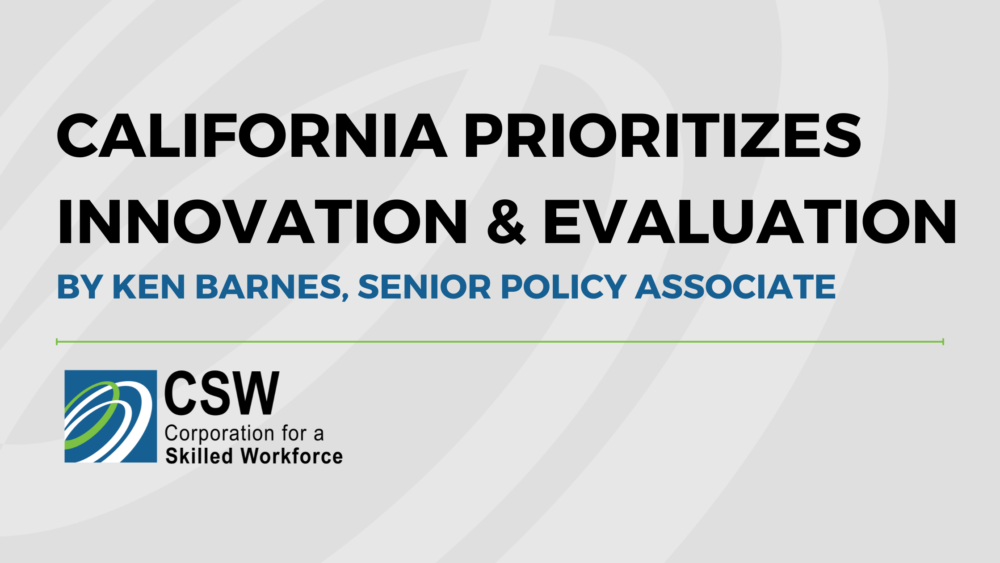In 2014, Corporation for a Skilled Workforce was asked by the California Workforce Development Board (CWDB) to help conceptualize an innovative new initiative to promote regional strategies aimed at placing California residents in well-paid growth sector jobs. The effort was driven by the theory that employers offering such jobs tended to be regional in their footprint, necessitating a regional approach to engaging with them. Jerry Brown had replaced Arnold Schwarzenegger as governor in 2011, and the mantra of the new administration was ‘re-inventing government.’ In that context, CWDB was intent on promoting regionalism as a critical new strategy for reducing poverty – and equally intent on evaluating the impact of that effort.
The resulting initiative, launched in 2015, was called SlingShot. Under it, California’s then 49 local workforce boards, along with a dozen other types of community stakeholders, were asked to form themselves into regions, identify a major regional workforce issue, and work together to address it. As a result, twelve regions each received $1M SlingShot grants.
Because SlingShot predated implementation of the Workforce Investment and Opportunity Act (WIOA), it put California in an excellent position to support the new regional planning expectations embedded in WIOA. While other states explored the possibility of creating regions that were larger than local workforce areas, California had already incentivized the establishment of regions via SlingShot. The twelve regions later evolved into fifteen, and SlingShot evolved, under WIOA, into the Regional Plan Implementation (RPI) initiative.
By 2017, CWDB was ready to evaluate the SlingShot/RPI initiative, along with a parallel effort known as the Workforce Accelerator Fund (WAF, or “Accelerator” for short). WAF attempted to balance SlingShot’s focus on major regional employers by providing funding to an assortment of local workforce boards and community-based providers aimed at reaching target populations experiencing barriers to employment. CSW was selected to coordinate the evaluation of both programs, with the assistance of BW Research Associates (for SlingShot) and Social Policy Research Associates (for Accelerator).
The SlingShot evaluation found that the various regions were at rather disparate stages of development – not surprising, given the vast economic, geographic and demographic differences between the regions. A rubric was developed by BW Research Associates which attempted to categorize the regions based on their level of development; this later evolved into the “Indicators of Regional Coordination and Alignment,” which CWDB has subsequently used to promote further regional development.
The Accelerator evaluation, meanwhile, found that the grantees had in fact been effective in reaching and serving various target populations, but that success had typically required shifts or pivots after an initial approach had been attempted and abandoned. Both SlingShot and Accelerator prioritized innovation, with CWDB assuring grantees that it was OK to take risks with this funding, and that trying something, failing, and trying something else was not only acceptable but encouraged.
CSW was subsequently selected to be the evaluator for the ongoing regional work under RPI (now approaching its fifth iteration, RPI 5.0), and has worked closely with CWDB, the regions and the local workforce directors to find ways to move regionalism forward that work for both local boards and the state. We started out as a ‘thought partner’ for the state in the planning stages of the effort, and find ourselves in a similar role several years later, helping the state learn to appreciate that local boards need to be allowed to embrace regionalism on their own terms, while helping local boards see that the state’s goals – impacting poverty, addressing inequity – are goals they share at the local level.
In 2018, the California Legislature approved funding for the Breaking Barriers to Employment initiative. Like Accelerator, Breaking Barriers is focused on ensuring that job-seekers with significant barriers to employment are well-served by the workforce system. The initiative, now in its second round of state funding, emphasizes the building of partnerships between local workforce development boards and community-based organizations with expertise serving specific populations.
CSW was selected as the evaluator for Breaking Barriers, again in partnership with Social Policy Research Associates, the Accelerator evaluator. The evaluation of the first round of funding showed that the grantees had in fact met their service goals – particularly impressive given that the project started just as COVID hit and California enacted a stay-at-home order, forcing everything to be moved on-line. The evaluation also indicated that work remains to be done to strengthen the partnerships between local boards and community organizations. Future evaluation efforts will look more comprehensively at employment and wage-gain outcomes for program participants.
In 2020, CSW was selected by CWDB to evaluate the state’s one-stop career center system, called America’s Job Centers of California (AJCC). CSW led an evaluation team which included the California Workforce Association and the Ray Marshall Center for the Study of Human Resources (University of Texas, Austin). The Ray Marshall Center conducted in-depth quantitative analysis of five years of WIOA data, while CSW developed case studies of twelve local workforce areas across the state involving extensive interviews with a range of partners and stakeholders. The final report, published in September 2022, found that AJCC customers who received training services, as opposed to other kinds of services, were more likely to find employment and to earn higher wages in that employment – notable, given that a number of previous studies have had difficulty demonstrating such a relationship. Recommendations included finding ways to augment training resources (while reducing the burden on local areas to document those resources), creating a more comprehensive data system capable of tracking non-WIOA expenditures, and explicitly making equity the unifying theme that ties state and local workforce efforts together.
In 2022, the California Legislature approved funding for Regional Equity and Recovery Partnerships (RERP). This initiative builds on the regional work done over the past several years, while bringing it to a new level by engaging the California community college system as a required regional partner. Each workforce region has been awarded multi-year funding, and separate funding will go to participating community college regions. CSW has been selected as the evaluator for RERP, starting in December of 2022.
For nearly a decade now, California has made innovation a cornerstone of workforce development policy and practice, and has demonstrated a commitment to evaluating each of its initiatives to see if it is contributing to the “north star” of income mobility. CWDB has built a strong internal team of researchers with evaluation expertise, while continuing to use external evaluators to ensure objectivity. The story that is emerging from these multiple evaluations is that of a highly complex system that is increasingly focused on equity as it works to support critical partnerships that can help low and moderate income residents obtain good jobs.
About the Author
Ken Barnes is a Senior Policy Associate at CSW. He lead CSW’s technical assistance and evaluation activities in support of California’s workforce development system, and oversaw evaluations of the state’s innovative Slingshot and Accelerator initiatives, and evaluating regional workforce activities across state. He previously assisted the City of Detroit in expanding education and training services for low-income residents through the US Department of Agriculture’s SNAP to Skills initiative.



Comments are closed.